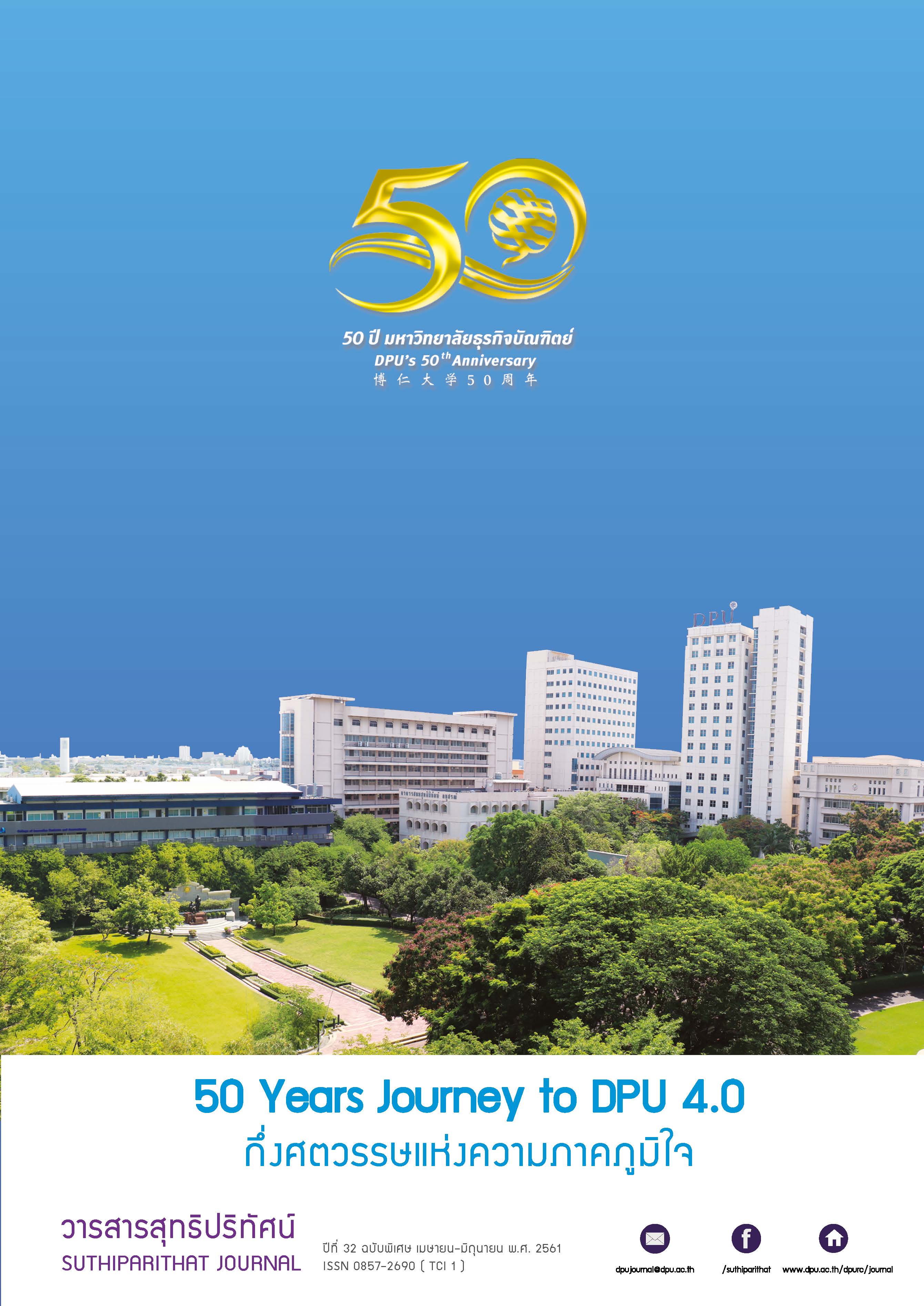SUCCESS FACTORS OF SAP IMPLEMENTATION OF ACCOUNTANTS IN LISTED INFORMATION TECHNOLOGY AND TELECOMMUNICATION ORGANIZATIONS IN THE STOCK EXCHANGE OF THAILAND
Keywords:
Employee Success Factor, Organization Success FactorAbstract
This research aims to study the success factors of SAP in FI module implementation in listed Information Technology and telecommunication organizations on the Stock Exchange of Thailand (SET). The SAP FI is financial accounting systems embedded in Enterprise Resources Planning (ERP) that comprise of finance accounting general ledger, finance accounting accounts receivable and payable, finance accounting asset accounting, finance accounting bank accounting, finance accounting travel management, finance accounting fund management, and finance accounting legal consolidation. The concept and Information System Success Model (IS Success Model) are used in the research. The population is the listed Information Technology and telecommunication organizations on the SET and 380 samples are accountants who work in organizations. Only 191 complete and returned surveys are used for data analysis stage.
Correlation and multiple regression analysis are used as the data analysis in this research. The research found that system quality factor is the most important in the samples’ opinion. User factor, consulting factor and organization factor are less important respectively. Moreover, all four factors positively influence on employee success and organization success indicators. Particularly, system quality factor is the highest influence on both indicators. In addition, user factor, consulting factor and organization factor are less influence on both indicators respectively.
References
เขมวันต์ ปิติวีรารัตน์, สินีรัชต์ พวังคะพินธุ์ และดร.อรพรรณ คงมาลัย. (2553, กรกฎาคม-กันยายน). ปัจจัยด้านกลยุทธ์ต่อความสำเร็จการประยุกต์ใช้ SAP กรณีศึกษา การประปานครหลวง. จุฬาลงกรณ์วารสาร 22(88), 31-38
ธานินทร์ ศิลปจำรุ. (2553). การวิจัยและวิเคราะห์ข้อมูลทางสถิติด้วย SPSS. กรุงเทพฯ. ห้างห้นุ สว่ นสามัญบิสซิเนสอาร์แอนด์ดี
ประพจน์ สุขมานนท์. (2545, กรกฎาคม). SAP คำตอบพื้นฐานของระบบ ERP. LEADER, 161
ประพจน์ สุขมานนท์. (2547). SAP R/3: ABAP Programming. กรุงเทพฯ: บริษัท พิมพ์ดี จำกัด
พงศ์พิไล วงศ์เจริญ. (2549). ความพึงพอใจของการนำ SAP มาประยุกต์ใช้ในมุมมองของนักบัญชีของธนาคารแห่งประเทศไทย. (วิทยานิพนธ์ปริญญา มหาบัณฑิต สาขาการบัญชี). กรุงเทพฯ: มหาวิทยาลัยธรรมศาสตร์.
พยัต วุฒิรงค์. (2550, เมษายน – มิถุนายน). วัฒนธรรมองค์การที่ส่งผลต่อความสำเร็จในการจัดการความรู้และ The Competing Values Framework (CVF). จุฬาลงกรณ์วารสาร, 19 (75), 5-23.
ภานรินทร์ เพชรรุ่ง. (2553). ปัจจัยที่มีอิทธิพลต่อความพึงพอใจของพนักงานในการใช้ระบบ SAP Module FICO ของการไฟฟ้าฝ่ายผลิตแห่งประเทศไทย. (การค้นคว้าอิสระปริญญามหาบัณฑิตสาขาการบัญชี). กรุงเทพฯ: มหาวิทยาลัยธรรมศาสตร์.
มานิตย์ เบ้าทอง. (2552). ความพึงพอใจในการนำ SAP มาประยุกต์ใช้ในการปฏิบัติงาน: กรณีศึกษาเจ้าหน้าที่ระดับปฏิบัติการของจุฬาลงกรณ์มหาวิทยาลัย. (วิทยานิพนธ์ปริญญามหาบัณฑิตสาขาการบัญชี). กรุงเทพฯ: มหาวิทยาลัยธรรมศาสตร์.
ระวีวรรณ อัศวชัยพร. (2552). ความพึงพอใจในการใช้ซอฟต์แวร์สำเร็จรูป SAP ECC 6.0 สำหรับระบบบริหารงานงบประมาณ พัสดุ การเงิน และบัญชีของ บริษัท วิทยุการบินแห่งประเทศไทย จำกัด. (การค้นคว้าอิสระปริญญามหาบัณฑิต สาขาการบัญชี). กรุงเทพฯ: มหาวิทยาลัยธรรมศาสตร์.
วัชนีพร เศรษฐสักโก, รศ ดร.. (2551). ระบบสารสนเทศทางการบัญชี. (พิมพ์ครั้งที่ 7). กรุงเทพฯ: วี.เจ. พริ้นติ้ง.
วาสนา วงค์สิทธิ์. (2543). การใช้โปรแกรมสำเร็จรูป SAP ของธนาคารออมสินสาขาเขต ภาค 5. (วิทยานิพนธ์ปริญญามหาบัณฑิต สาขาการบัญชี). เชียงใหม่: มหาวิทยาลัยเชียงใหม่
วีระยุทธ์ กิตะพาณิชย์. (2554: พฤษภาคม – มิถุนายน). Smart Solutions, 38 (May-June, 2011) สำนักงานคณะกรรมการกิจการโทรคมนาคมแห่งชาติ. ประกาศคณะกรรมการกิจการโทรคมนาคมแห่งชาติ. สืบค้นเมื่อ 30 เมษายน 2554 จากhttp://www.ntc.or.th/index.php?option=com_content&task=category§ionid=9&id=114&Itemid=185
อัญญารัตน์ ธนไพศาลกิจ . (2552). ปัจจัยที่นำไปสู่ความสำเร็จของโครงการติดตั้งระบบ SAP ในหน่วยงานภาครัฐ: มุมมองของฝ่ายลูกค้าและฝ่ายผู้ให้บริการติดตั้งระบบ. (การค้นคว้าอิสระปริญญามหาบัณฑิต วิทยาลัยนวัตกรรม). กรุงเทพฯ: มหาวิทยาลัยธรรมศาสตร์.
Cochran, W. G. (1977). Sampling techniques (3rd ed.). New York: John Wiley & Sons.
Deshpande, R., and Webster, F. E. (1989). Organizational Culture and marketing – Defining the research agenda. Journal of Marketing, 53(1), 3-15.
Holland, C. and Light, B. (2003). A Framework for Understanding Success and Failure in ERP System Implementation. Second-Wave ERP Systems. Chapter 7: 180-195.
Hong L. Y. (2009). Effects of Enterprise Resources Planning (ERP) Systems Adoption on Production Performance in Manufacturing Industry: Using A Multinational Plastic Manufacturing Company Implemented SAP R/3 as an Example. Taiwan: National Sun Yat-sen University.
Wang, E. T. G., and Chen, J. H. F. (2006). Effects of internal support and consultant quality on the consulting process and ERP system quality. Decision Support Systems, 42, 1029-1041.
White, E. M., Anderson, J. C., Schroeder, R. G., and Tupy, S. E. (1982). A study of the MRP implementation process. Journal of Operations Management, 2, 145-153.
Yang X. (2009). Applying SAP ERP system in Business Processes, Case City of Tampere. UNIVERSITY OF APPLIED SCIENCES.
Yusuf, Y., Gunasekaran, A., and Abthorpe, M. K. (2004). Enterprise information systems project implementation: A case study of ERP in Rolls-Royce. International Journal of Production Economics, 87, 251-256
Zhang, L., and Li, Y. (2005). Probe into the way to implement ERP system in terms of systems theory in China. (Working paper). Beijing: Beijing Jiaotong University.
Downloads
Published
How to Cite
Issue
Section
License
Content and information of the article published at Suthiparithat Journal are based on the sole opinions and responsibility of author(s) only. Neither the editorial board involve in......






